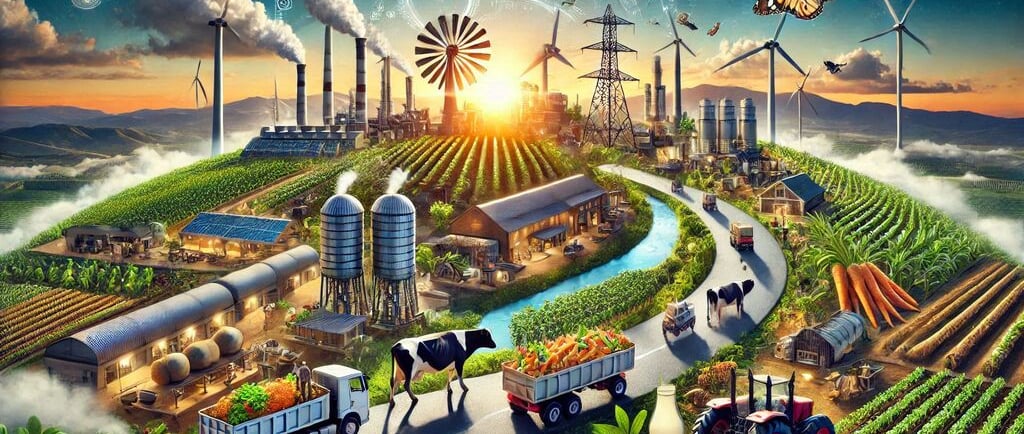Let us collaborate to foster global growth and development together.
India's Agricultural Revolution: Innovations Driving Agro-Food Processing
Explore India’s agricultural revolution with innovations in agro-food processing, transforming how food is cultivated, processed, and consumed globally.
INDIA
10/31/20243 min read


India's Agricultural Revolution: Innovations Driving Agro-Food Processing
Meta Description: Explore India’s agricultural revolution with innovations in agro-food processing, transforming how food is cultivated, processed, and consumed globally.
India is experiencing an agricultural revolution powered by innovative technologies, efficient processes, and government reforms. With its agro-food processing industry poised to become a global leader, India’s transformation has significant implications for global food security, sustainable farming, and economic growth. Let’s explore the cutting-edge innovations driving this shift and what it means for businesses and consumers worldwide.
Why Agro-Food Processing Is Crucial for India
The Agricultural Backbone
India's economy has long been rooted in agriculture. Contributing approximately 18% of the nation’s GDP and providing livelihoods to over 50% of its population, agriculture remains a critical sector. However, challenges such as post-harvest losses, inefficiencies in logistics, and inconsistent quality standards hinder its full potential.
Agro-food processing bridges this gap, adding value to raw agricultural produce and ensuring longer shelf life, better marketability, and higher farmer incomes. From wheat becoming packaged bread to mangoes being turned into global-quality pulp, the transformation is remarkable.
Feeding a Growing Global Demand
The global population is projected to reach 9.7 billion by 2050, demanding innovative solutions to meet food requirements. India’s advances in agro-food processing cater not just to domestic needs but also to burgeoning export demands.
Innovations Powering India’s Agricultural Revolution
1. Smart Farming Technology
Technology is revolutionizing farming practices across India.
Precision Agriculture: Using IoT sensors, farmers can monitor soil health, moisture levels, and crop growth in real-time, maximizing yields while conserving resources.
Drones and Satellite Imaging: Advanced drones and satellite technologies enable efficient pesticide application and detailed crop analytics.
For example, startups like Fasal and DeHaat have introduced smart solutions that empower small farmers with actionable data.
2. Cold Chain Infrastructure
Post-harvest losses account for nearly 30-40% of agricultural produce in India. To counter this, India is heavily investing in cold chain infrastructure.
Refrigerated Storage Units: Companies are setting up cold storage warehouses that ensure fresh produce reaches consumers in its best condition.
Temperature-Controlled Logistics: Advanced transportation systems reduce waste and extend shelf life, making products export-ready.
3. Food Processing Innovations
Cutting-edge food processing techniques are transforming raw produce into high-value exports.
Minimal Processing Techniques: Methods like vacuum frying and freeze-drying retain natural flavors and nutrients.
Fortified Foods: The growing trend of value-added and fortified products helps combat malnutrition while boosting consumer interest.
Examples include fortified rice or protein-enriched snacks that address nutritional gaps.
Government Initiatives Supporting Agro-Food Processing
The Role of Policy and Investments
The Indian government has launched several initiatives to support agro-food processing:
Pradhan Mantri Kisan Sampada Yojana (PMKSY): A comprehensive scheme focused on creating modern agro-processing facilities and reducing post-harvest losses.
100% FDI in Food Processing: This has encouraged global brands like Nestlé and Unilever to invest in India.
Cluster Development and SEZs
Dedicated food parks and Special Economic Zones (SEZs) are providing food processing units with state-of-the-art facilities, from cold storage to logistical hubs.
Challenges That Still Persist
Smallholder Integration
Over 85% of Indian farmers operate on less than two hectares of land, making them vulnerable to market fluctuations and resource shortages. Addressing this requires further integration of smallholder farmers into the value chain through cooperatives and training.
Sustainability Concerns
While innovation drives production, the sector must ensure that environmental sustainability remains a priority. Sustainable practices, such as organic farming and water conservation, need to scale up significantly.
Opportunities for Businesses
Local and Global Trade Expansion
India’s agro-food sector offers untapped business opportunities:
Export Potential: With processed foods like basmati rice, spices, and frozen vegetables in high demand globally, export growth is ripe.
Collaborative Innovation: International businesses can collaborate with Indian startups or manufacturers to create innovative solutions for food sustainability.
Investments in Agri-Tech
Venture capitalists and large enterprises are showing increasing interest in agri-tech. With a projected CAGR of 15% for India’s food processing market by 2027, early investment offers significant returns.
Real-Life Examples of Success
Amul: The Dairy Revolution
Amul, one of India’s largest food brands, showcases the success of farmer cooperatives and cutting-edge milk processing to create global demand for Indian dairy.ITC Limited:
ITC's agro-business division transforms wheat into flour and pulses into ready-to-eat meals, efficiently linking farms to global markets.
A Look Ahead: The Future of Agro-Food Processing
India’s agricultural revolution is far from over. The sector continues to adopt AI, blockchain, and robotics, promising even greater efficiency and traceability.
Blockchain: Enhances transparency by tracking the journey of food from farm to table.
Automation: Increases efficiency in large-scale food production facilities.
Conclusion: Join India’s Agricultural Evolution
India’s agricultural revolution is transforming how the world eats, using technology, policy support, and innovation to lead the way in agro-food processing. With growing exports, sustainable practices, and smallholder inclusion, the future is bright for this vital industry.
If you’re an entrepreneur or investor, the time to explore opportunities in India’s agro-food processing industry is now.
What do you think about India’s agro-food processing sector? Let us know in the comments or check out related posts like “Technologies Transforming Food Processing” or “Sustainable Practices in Modern Agriculture.”
Innovation
Cutting-edge solutions for industrial efficiency and productivity.
© 2024. All rights reserved.


